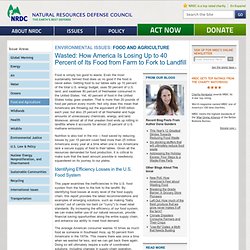

Comment nourrir tout le monde ? Taste the Waste - Nos Poubelles Passent A Table. Www.familyfarmed.org/wp-content/uploads/2013/06/OFFS-Website-PPT.pdf. Le gaspillage alimentaire à l'origine d'un gâchis écologique. One-third of the world's food goes to waste, says FAO. A Filipino scavenger collects food waste from a market in Manila, Philippines.

Photograph: Joshua Mark E Dalupang/EPA One-third of the world's food produced for human consumption is lost or wasted each year, according to a study (pdf) released on Wednesday by the UN Food and Agriculture Organisation (FAO). Roughly 1.3bn tonnes of food is either lost or wasted globally due to inefficiencies throughout the food supply chain, says the report, based on research by the Swedish Institute for Food and Biotechnology (Sik). Amid rising global food prices, the study says that reducing food losses in developing countries could have an "immediate and significant" impact on livelihoods and food security in some of the world's poorest countries.
According to the report, industrialised and developing countries waste or lose roughly the same amount of food each year – 670m and 630m tonnes respectively. Le gaspillage alimentaire: causes, impacts et propositions. L’analyse menée en 2011 par la FAO estime que la quantité de gaspillage alimentaire dans le monde s’élève à 1,3 milliard de tonnes par an, soit environ un tiers de la production totale de denrées alimentaires destinée à la consommation humaine, tandis qu’une autre étude (Smil, 2010) indique que 43% seulement de l’équivalent calorique des produits cultivés mondialement dans un but alimentaire sont directement consommés par les humains.

Les institutions et la littérature spécialisée définissent le gaspillage alimentaire de manières différentes malgré le manque d’une définition univoque du phénomène, ou de données homogènes ou comparables. Le BCFN propose une différentiation entre : - « Food losses » (pertes alimentaires), c’est-à-dire les pertes qui se produisent en amont de la chaîne alimentaire, principalement pendant les phases de semis, culture, récolte, traitement, stockage et première transformation agricole ; Comment enrayer un phénomène qui se révèle systémique de nature? Wasted: How America Is Losing Up to 40 Percent of Its Food from Farm to Fork to Landfill. Food is simply too good to waste.

Even the most sustainably farmed food does us no good if the food is never eaten. Getting food to our tables eats up 10 percent of the total U.S. energy budget, uses 50 percent of U.S. land, and swallows 80 percent of freshwater consumed in the United States. Yet, 40 percent of food in the United States today goes uneaten. That is more than 20 pounds of food per person every month. Not only does this mean that Americans are throwing out the equivalent of $165 billion each year, but also 25 percent of all freshwater and huge amounts of unnecessary chemicals, energy, and land.
Nutrition is also lost in the mix -- food saved by reducing losses by just 15 percent could feed more than 25 million Americans every year at a time when one in six Americans lack a secure supply of food to their tables. Identifying Efficiency Losses in the U.S. This paper examines the inefficiencies in the U.S. food system from the farm to the fork to the landfill.
Institution of Mechanical Engineers. Feeding the 9 Billion: The tragedy of waste By 2075, the United Nations’ mid-range projection for global population growth predicts that human numbers will peak at about 9.5 billion people.

This means that there could be an extra three billion mouths to feed by the end of the century, a period in which substantial changes are anticipated in the wealth, calorific intake and dietary preferences of people in developing countries across the world. Such a projection presents mankind with wide-ranging social, economic, environmental and political issues that need to be addressed today to ensure a sustainable future for all. One key issue is how to produce more food in a world of finite resources. Today, we produce about four billion metric tonnes of food per annum. Read the Global Food report [PDF, 1MB] Where Food Waste Happens Fully developed, mature, post-industrial societies, such as those in Europe, characterised by stable or declining populations which are increasing in age.
Www.fao.org/docrep/014/mb060e/mb060e00.pdf.